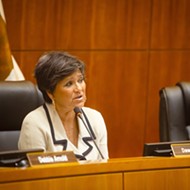Treading underwater: The water board is not happy with the Cambria Community Services District
By Karen Garcia[{
"name": "Newsletter Promo",
"id": "NewsletterPromo",
"class": "inlineCenter",
"insertPoint": "4",
"component": "15264767",
"requiredCountToDisplay": "0"
},{
"name": "Ad - Medium Rectangle CC01 - 300x250",
"id": "AdMediumRectangleCC01300x250",
"class": "inlineCenter",
"insertPoint": "8",
"component": "2963441",
"requiredCountToDisplay": "12"
},{
"name": "Ad - Medium Rectangle LC01 - 300x250",
"id": "AdMediumRectangleCC01300x250",
"class": "inlineCenter",
"insertPoint": "18",
"component": "2963441",
"requiredCountToDisplay": "22"
},{
"name": "Ad - Medium Rectangle LC09 - 300x250",
"id": "AdMediumRectangleLC09300x250",
"class": "inlineCenter",
"insertPoint": "28",
"component": "3252660",
"requiredCountToDisplay": "32"
}]
The Cambria Community Services District is in the hot seat with the Central Coast Regional Water Quality Control Board, which is threatening to revoke the district’s water treatment facility permits and/or to issue a potential penalty of $600,000.
On Feb. 9, the water board issued three violations to the district for constantly being late with report submittals and for failed water quality compliance due to a flooding issue at the district’s water facility in January.
“Water board staff considers the chronic failure to submit timely reports and updates of significant changes … to be egregious violations of water quality regulations and orders, and as such to pose a serious threat to the integrity of the water board’s regulatory program and water quality,” the notice of violations stated.
Cambria is required to update the water board on its Sustainable Water Facility operations monthly, quarterly, and annually through self-monitoring reports. The water treatment plant was built in 2014 to take in a mix of fresh and salt water called brine and spit out potable water for the community. The water board sent email and phone call reminders of the deadlines, but the district still failed to meet them 84 percent of the time. Since 2015, only four of the 32 self-monitoring reports were turned in on time, according to the water board notice.
This compliance issue came up after the January flooding incident at the facility prompted Cambria resident Tina Dickason to notify the water board. Storm water and debris were flooding into the facility’s brine pond, which filters nonpotable water back into the ground. Dickason was sending emails with photographs of the ever-increasing water levels to water board engineer Ryan Lodge. She said she called Lodge Jan. 10 about the potential contamination flooding could cause to other water sources. When water board staff visited the site off San Simeon Creek Road, they saw that the storm water was disturbing the pond’s normal drainage process.
The district failed to notify the water board of the flood within the required 24 hours and missed the 14-day deadline to file a report on the incident. Matthew Keeling, a senior engineer for the water board, said that other local water facilities occasionally fail to meet the reporting requirements, but it’s uncommon. He said there are usually two reasons notifications are late: Either the district’s working on alleviating the emergency or it doesn’t understand the reporting requirements. In Cambria’s case, he said it was a combination of both.
“Luckily for the district, the flooding event was not reasonably foreseeable and does not appear to have been caused by any action or inaction of the district, and they were able to divert the flooding around the brine holding pond before it filled up and overflowed,” Keeling said.
District General Manager Jerry Gruber told New Times via email that past experiences such as the potential for sewage overflow and downed trees were what he was thinking about at the time.
“When you are in emergency mode from heavy rains it is easy to get complacent and think a situation like the brine pond could wait a day,” Gruber said, adding that the district needs to do a better job communicating with the water board.
“We need to build a partnership built of trust and transparency and to not be afraid to pick up the phone and say we need your help,” he said.
Dickason’s phone call about the flooding came up at the district’s meeting on Jan. 19. At the time, Gruber told Dickason that she was harassing both the district and the water board with constant emails about the brine pond. It turned into a tense back-and-forth between the two. The friction at the meeting coupled with the district’s chronic tardiness pushed the water board to respond with the threat of imposing penalties against the district.
“We do not agree with your representation of our position regarding information we receive from Ms. Dickason or other members of the public. We value the information and reports we get from citizens, and we request that you publicly retract your statements,” the violations notice said.
Dickason said the notice validated her decision to notify the water board about the flooding prior to communicating with the district about it. She said she went around the district because she didn’t trust that it would do the right thing.
“I could tell that there were issues out there that weren’t being dealt with and that the regional board has oversight over the district,” she said.
Dickason has lived in Cambria since 2003 and said she has always been politically active in the community. She voiced opposition to the Sustainable Water Facility from the beginning, when the district talked about its fear of a future scarcity of water. Dickason believes the project was created with haste and has cost the district millions of dollars it doesn’t have, she said. And now that the facility is up and running, her main concern is how the district is going to get rid of brine waste—that salty water in the recently flooded pond.
“Every day that [the pond] has been draining, it has been inching up higher and higher,” she said. “We’re not even through with the rainy season yet.”
The district has an opportunity to keep its permits and avoid penalties by submitting plans to maintain its brine pond and future oversight by March 1.
You can reach staff writer Karen Garcia at [email protected].
Latest in News
Readers also liked…
-

SLO police identify alleged driver who hit and killed couple
Dec 22, 2022 -

When the levee breaks: Oceano residents, county officials walk a tightrope of regulations to manage Arroyo Grande Creek, which some say led to the levee's failure in January
May 18, 2023 -

Cal Poly report highlights offshore wind's potential to spur green energy transition
Jun 8, 2023









